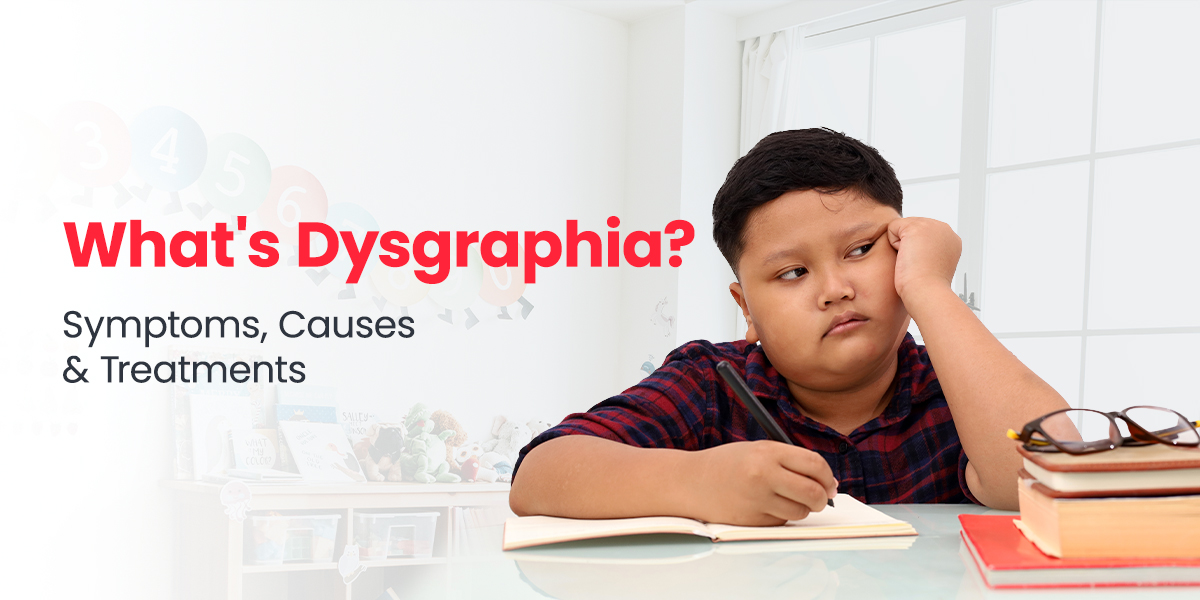What is Dysgraphia? Symptoms, Causes & Treatments

What is Dysgraphia?
Dysgraphia is a neurological learning disorder that makes writing unusually difficult, even when a person has normal intelligence and has received proper education. It is not caused by laziness or poor teaching but is linked to the way the brain processes language, fine motor skills, and memory.
Writing is a complex skill. It requires:
- Fine motor control to hold and move a pen or pencil.
- Spatial awareness to place letters and words correctly on a page.
- Working memory to keep track of ideas while writing.
- Language processing to connect thoughts with words and grammar.
- Organization and planning to structure sentences and ideas.
Because so many skills are involved, dysgraphia can manifest differently in each person. Some children struggle with handwriting, while others find it hard to express their thoughts clearly in writing.
Types of Dysgraphia
- Developmental Dysgraphia: Appears in childhood when a child first learns to write.
- Acquired Dysgraphia: Can occur suddenly in adults or children after a brain injury, stroke, or other neurological condition.
Dysgraphia vs. Dyslexia
Dysgraphia and dyslexia are different but often occur together.
- Dyslexia affects reading and recognition of words.
- Dysgraphia affects the act of writing—spelling, handwriting, or organizing ideas
Who Can Be Affected?
- Dysgraphia may affect both children and adults.
- It is more commonly diagnosed in boys.
- A family history of learning difficulties can increase Its chances.
- Children with ADHD or autism spectrum disorder are at a higher risk
Research suggests that 5% to 20% of people may have some form of dysgraphia, though many cases go undiagnosed.
Signs and Symptoms of Dysgraphia
Children or adults with dysgraphia may:
- Write letters unevenly or with poor spacing.
- Struggle to hold or control a pen/pencil.
- Reverse letters or mix up uppercase and lowercase.
- Omit words, misplace pronouns, or misuse grammar.
- Have slow writing speed compared to peers.
- Speak fluently but struggle to put ideas into written words
It is important to note that one symptom alone does not confirm dysgraphia. A proper evaluation is needed.
Causes of Dysgraphia
The exact cause is not fully understood, but it may be linked to:
- Differences in brain activity during writing tasks.
- Genetic factors (runs in families).
- Neurological injury (in acquired cases)
Diagnosis of Dysgraphia
Since dysgraphia does not have a single medical test, diagnosis involves:
- Reviewing handwriting samples.
- Assessing motor skills, spelling, grammar, and sentence formation.
- Looking at the child’s educational history and progress.
- Evaluation by specialists such as:
- Occupational therapists
- Speech therapists
- Neuropsychologists
- Educational psychologists
Early diagnosis is the key because cognitive demands progressively increase as children move to higher classes in school.
Management and Treatment
There is no medication for dysgraphia, but various strategies help:
1. Educational Support
- Accommodations: Allowing extra time for written tasks, using computers, or oral answers.
- Modifications: Adjusting academic expectations to reduce stress.
- Remediation: Targeted therapies to improve handwriting, spelling, and organization
2. Therapeutic Interventions
- Occupational therapy to strengthen fine motor skills.
- Special handwriting instruction.
- Visual-motor integration exercises
3. Assistive Tools
- Typing instead of handwriting.
- Speech-to-text software.
- Graphic organizers to help structure essays
Living with Dysgraphia
Dysgraphia does not reflect a lack of intelligence. With early diagnosis, supportive teaching, and modern technology, children and adults can succeed academically and professionally.
Parents and teachers play a key role in encouraging children, providing emotional support, and ensuring that the child is not mislabelled as “lazy” or “careless.”
Conclusion
Although dysgraphia cannot be prevented, it can be successfully managed. With the correct strategies and proper support, individuals with dysgraphia can develop confidence in their abilities and perform well in school and profession.
If you suspect your child has dysgraphia, consult a healthcare professional. At Regency Healthcare, regarded as one of the best hospital in Kanpur, our specialists provide accurate assessments and interventions to help your children shine and reach their full potential.
Also Read: ADHD in Kids: Early Signs Parents Shouldn’t Ignore

 Call-an-Ambulance
Call-an-Ambulance



